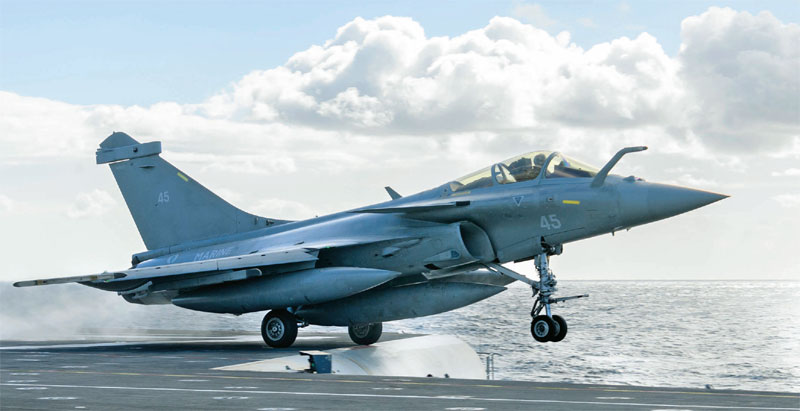Fighters At Sea
Atul Chandra
The Indian Navy needs to urgently decide on its future carrier-borne fighter aircraft and induct and operationalise the fleet before the end of the decade if it is to address the growing asymmetry between the People’s Liberation Army Navy (PLAN), which has stated plans to operate six aircraft carriers in the future.

French Navy Rafale-M aircraft being launched from the aircraft carrier Charles De Gaulle
The PLAN will also induct and operationalise an advanced carrier borne fighter aircraft before the end of the decade. The aircraft, referred to as the Shenyang J-35, is thought to be a navalised derivative of the FC-31. According to the Aviation Industry Corporation of China (AVIC), which is the manufacturer of the FC-31, the single-seat, twin-engine multi-role fighter jet is 17.3 meters long with a wingspan of 11.5 meters. When the J-35 enters service on PLAN aircraft carriers, the stealthy aircraft will provide a quantum leap in capability over its existing Shenyang J-15s. Publicly available images of the J-35, show the new Chinese fighter having a surprising similarity with the US F-35 fifth generation fighter jet.
China launched its third aircraft carrier in June and it will have a displacement of more than 80,000 tonne and be fitted with electromagnetic catapults. The Fujian will also likely be the first of the three PLAN carriers to deploy the J-35. The use of electromagnetic catapults will allow the new aircraft carrier, which is named Fujian (Hull 18) to also launch a carrier-based early warning aircraft (thought to be a derivative of the KJ-600 early warning aircraft) and a carrier-based advanced jet trainer (likely the JL-10). Surprisingly, despite China’s success in development of Medium Altitude Long Endurance (MALE) Unmanned Aerial Vehicles (UAV), many of them armed; there does not appear to be a publicly announced maritime carrier borne version of these platforms.
The PLAN’s existing aircraft carriers, CNS Liaoning (Hull 16) and CNS Shandong, (Hull 17) can carry 24 and 36 Shenyang J-15 carrier-borne fighters. Both the carriers feature Ski-Jump designs, which limit their ability to launch larger and heavier aircraft. The Shenyang J-15 is an unlicenced Chinese copy of the Sukhoi Su-33 and is presently the PLAN’s only carrier borne fighter type. PLAN Shenyang J-15s landed and took-off from CNS Liaoning for the first time in November 2012 an
Subscribe To Force
Fuel Fearless Journalism with Your Yearly Subscription
SUBSCRIBE NOW
We don’t tell you how to do your job…
But we put the environment in which you do your job in perspective, so that when you step out you do so with the complete picture.







